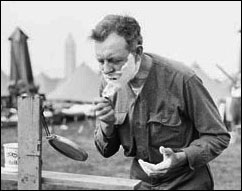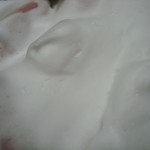Category Archives: Lathering, Soaps, & Creams
Third Video – Bowl Lathering & the Soap/Water Ratio
How to Lather Soft Soap (Croap or Italian Soap)
First Shaving Video
First of many I hope!
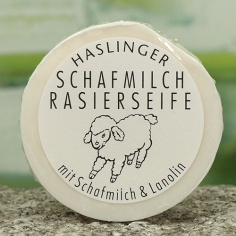
Haslinger Ewe’s Milk Shaving Soap Review
I received this soap in a trade.
Okay, so I can’t actually read anything about the packaging, but from what I’m told it is a tallow based soap with lanolin. Hence the little sheep on the package. Honestly, other than that I don’t really have too much background on this soap. It appears to be German and is sold on the Shavemac website. All I can say about it is that it comes in a rather small puck compared to most other soaps. Simple packaging as you can see. Comes with a cute little lamb on it too. So, without further extrapolation, on to how it performs!
Loading
This soap loads like a triple milled soap. Which is to say, it takes a little longer to load. But that is fine, I’m used to triple milled soaps. I much prefer them to be honest. Much more bang for the dollar. Anyway, after about 30 seconds of loading, I’ve built up the requisite thick proto lather on the puck. Note: It’s pretty small so I just hold the puck in my hand instead of putting it in a glass bowl like my other soaps. It did come with a small plastic container, but holding it in my hand was easier.
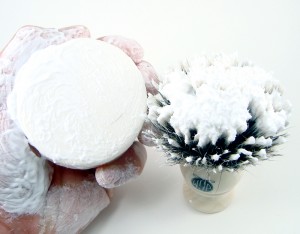
As you can see, it loaded up very nicely. I’ve got a thick proto lather going and I’m ready to start face lathering. Brush used is the Monarch in Super Silvertip.
Lather-ability
This soap doesn’t quite explode into lather like Martin de Candre or some creams. It takes a bit of work and is a pretty thirsty soap like D.R. Harris. But that’s okay, I don’t expect my soaps to explode into a lather. I want my soap to be slick and cushioning. So, after a few dips into water, I’m able to build a nice layer of lather on my face. Now, I don’t have any face shots since my head doesn’t fit into my light box, but I’ve lathered the back of my hand so you can see the thickness of lather I’m using.
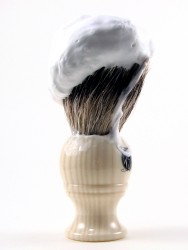
Like I said, it doesn’t explode into lather, but it builds a nice lather. And if you really wanted to, you could build it very thick (DE users). That said, I would say it builds lather easily enough. I didn’t need too much effort. In addition, getting the ratio I prefer was quite easy as well.
Performance
On to the important part, how it performs. In this reviewer’s opinion, the soap performs excellently. Right up there with D.R. Harris in performance. Very slick lather. Perfect for straight razor shaving. The razor didn’t get caught up on any hairs like I’ve experienced the other day using the reformulated GFT soap. Instead, I was rewarded with ultra slick lather. Now, I can’t really comment too much about cushion as I don’t understand what people are talking about since I use a straight razor. I will say that the soap seems to protect the skin pretty well. Anyway, the soap performed very well. Very slick. I like it. Here’s some shots of the lather.
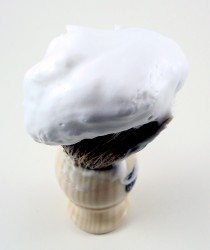
Conclusion
Since I didn’t pay for this soap, I cannot comment on it’s value. But at 4.5 Euros, it seems like a pretty good deal to me. The performance is top notch. Very suitable for straight razor shaving, giving that slickness that the straight razor really needs. As you can see, the lather is quite thick and cushion-y looking. Compared to Mitchell’s Wool Fat, this soap is slightly easier to lather with and is definitely less finicky. More user friendly. Performance wise, they seem to perform about the same. Haslinger’s is slightly slicker in my estimation.
The scent is pretty much non-existant. I didn’t smell anything for the lathers I did, except for the lingering badger stink of my Monarch Super Silvertip.
In conclusion, I would definitely recommend this soap if you like tallow and lanolin.
Hard Water Lathering Problems – You Should Try Filtered Water
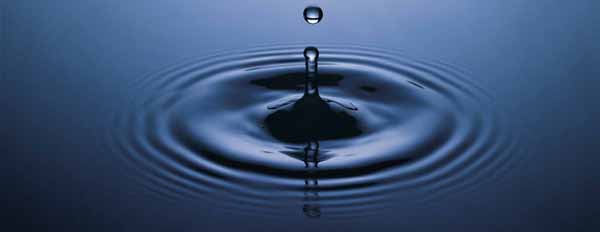
All of us want a better lather right? In our search for a better lather, we have found RO water to be far superior to tap water. Now, if you live in someplace like Hawaii, where the water is pristine, fresh, and is not hard… well, we hate you. But for the rest of us, hard water is a cold hard reality. Hard water makes for a less than stellar lather, does not produce as much lather, is not as slick as it can be, and is hard on your brush(es). The solution is filtered water. Removing all or most of the calcium and fluoride will make for a much better lather, and keep your brush cleaner, longer.
Why Hard Water is Bad
First, we must examine what hard water is. Hard water is water that has a large amount of dissolved minerals, such as calcium and magnesium. The more minerals in your water, the harder it is. In fact, the term hard water originated from our forebears having difficulty lathering with said water. It was, and still is, “hard water” to lather with. Getting even more technical, it is the Group 11 alkali earth minerals (particularly calcium or magnesium) which make the water hard. Learn more about them here. These minerals are either missing or in significantly reduced concentrations in soft water. I don’t know why its called soft water other than its the opposite of hard.
So why do the minerals interfere with the lathering process? Well, believe it or not, hard water makes lathering any soaps harder. Including your daily hand, dish, and body cleansing soaps. Soap is made from sodium byproducts, the result of combining animal or vegetable oils and fats with lye in a process called saponification, that easily bubble into a full lather when combined with pure water. When combined with soft water, the soap serves as a surfactant. The Calcium and Magnesium molecules interferes with this process. Instead of producing rich, bubbly lather, hard water makes a white precipitate (soap scum) instead. “This effect arises because the 2+ ions destroy the surfactant properties of the soap by forming a solid precipitate (the soap scum).” Wikipedia.
Thus, hardness is scientifically defined as the soap consuming properties of a water sample.
While there are many methods used to combat hard water, from boiling the water to using baking soda. The best method by far is to use enhanced water. Enhanced through actual filtration or through a soft water system.
Filtered Water
I really like RO water, but understandably, most people do not have RO systems in their houses, and they are expensive. Bottled water would be ridiculous. A water filter from Brita or Pur is not particularly expensive and will produce good results. Either the over the faucet or pitcher model will work well. And you get to drink better tasting water!
If you want the same results as RO water without the expense, go to your store and pick up a gallon of distilled water. It should only cost a dollar or two. Otherwise, buy a half gallon. Distilled water is very inexpensive and will produce the same effects as RO water. If you live in a hard water area, you really need to try soft water. It makes lathering so much easier and enjoyable.
How to Face Lather
Face lathering is a simple process requiring nothing more than hot water, a brush, and soap. This lathering procedure is superior to any other in our opinion. The lather is hotter. It stays hotter longer, and the lathering action on your face really gets the lather into the stubble. But mostly, the hot lather feels much more soothing. Finally, you have one less dish to wash.
The first step is to soak the brush in hot water for at least a minute. We recommend washing your face or taking a shower while you soak the brush. This step is important because the brush hairs need to soak up water for maximum efficiency. Once your ready to start lathering, ring out the brush by squeezing out the excess water. But be careful, you only need to remove enough water so that your brush doesn’t drip everywhere. Water is good.
The next step is to load up the brush. There is no right way or best way to do this. We use the same circular motion used to lather. You can also spin the brush, making half rotations. You don’t want to load up with too much soap because you’ll have to add a lot of water to thin out the lather. You can always add more soap if the lather isn’t building, but you can’t remove soap; you can only add water. Experience will tell you how much soap you need.
Next, dip the tip of the brush in the bowl of hot water. You did keep it right? Then, start lathering one cheek until a good lather builds. Use the regular circular motions you’ve always used to build lather, only this time lather on your face instead of a bowl or your palm. Once a good lather has been built up, paint the lather on your neck, chin, and mustache. Finally, use the circular motion to build up lather on your other cheek. Once the lather has been built, paint the lather on any spots you missed.
At this point, the lather either is or isn’t to your liking. If it is, start shaving! If not, follow these simple troubleshooting steps. For lather that is too thick, dip the brush in water again and repeat the lathering procedure. This will thin out the lather. Depending on how thick the lather is, you can just use painting strokes to apply and thin out the lather. If the lather is too thin, re-soap the brush and repeat the entire procedure until the lather is thick enough to your liking.
And that’s it. Simple right? How do you lather? Tell us in the comments below.
Our Thoughts on Glycerin Soap
Someone asked the other day why we don’t have more articles on lathering. The truth is that we’ve been concentrating on writing other articles and tips. We apologize to lather for neglecting it so. Yet, the truth is that we kind of give lather a short shrift and nary a second thought. We use tallow soap pretty much exclusively due to its superior characteristics v. glycerin. In this post we’ll give you our thoughts regarding glycerin soap as we continue working on our review of Groom Room Essence of Scotland Soap.
While we do believe tallow soap is a superior product in terms of straight razor shaving use, we recognize that it isn’t for everyone. Read our endorsement of tallow soap here! Glycerin soap’s main ingredient is glycerin. The by-product of either soap making or bio-diesel, glycerin can be vegan friendly. Whereas tallow must be reduced from animal fat, glycerin can be produced from other sources.
We’ll start off our actual thoughts on the performance of glycerin soaps in shaving applications with the general observation that for the most part, all glycerin soaps shave the same. Whatever the reason, unless you purchase a bad batch of glycerin shaving soap, the end product is going to feel more or less the same. This is not to say that there are not bad soaps, but all the good glycerin soaps more or less perform the same. Of the soaps we’ve tried, Edwin Jagger’s line disappointed us the most.
Glycerin soap lathers up easily and quickly. It can produce some incredibly thick lather. In fact, the lather you can produce with glycerin soap is much thicker and creamier than what you can produce with tallow soap. This is certainly the soap of choice for fans of super lather. Just look at the picture to the right. I just whipped up some glycerin soap in my hand for this article and took a picture. For a picture of glycerin soap applied to the face, click here.
This thickness serves to truly cushion the face during the shave. However, unlike tallow soap, this lather is extremely thick and not the most conducive to straight razor shaving. While the end result is more or less the same in the hands of a skilled practitioner, tallow soap is much slicker and easier to glide the straight razor across. In an upcoming article we will show you the perfect straight razor shaving lather consistency using tallow soap.
Glycerin soap has two more benefits worth mentioning. The first is the smell. Oh, the fragrances you can purchase. They are both numerous and unique. As varied as the number of soap makers, and there are many. The second is the clean feeling it leaves. Glycerin soap just wipes off clean and leaves you feeling fresh and clean. It does leave the skin a little drier though. We recommend using an spf moisturizer in either case.
Glycerin soap makers are limited only by their imagination and the availability of fragrances for their soaps. Unlike tallow soaps which come in only a handful of fragrances (most of them admittedly “vintage smelling”), glycerin soaps come in an infinite variety of fragrances. From citrus notes to woodland tones you can find whatever fragrance tickles your fancy that morning.
So, to sum up the article, glycerin soap gives an incredibly thick lather, can be vegan friendly, and comes in a dizzying array of fragrances. While we still prefer tallow soap, glycerin soap is a very close second. What is your favorite soap? Tell us in the comments.
How to get a Good Shave with Canned Shaving Gel
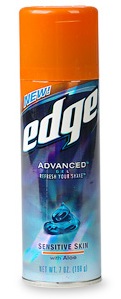 I should start this post by saying that you shouldn’t be using canned shaving gel in the first place. Aside from releasing all the compressed gasses used to push out the gel, your face and straight razor deserve better. Canned goo simply does not offer the slickness, cushioning, and comfort that shaving soap does. Nothing gives you a better shave than a wet-shave using a finely honed straight, a brush, and tallow soap. However, there are some situations where brush and puck or cream simply is not available. Perhaps you’re traveling or the world ended and all that’s left is Edge Shaving Gel. Whatever the reason, this post is to help you get the best straight razor shave possible using canned cream.
I should start this post by saying that you shouldn’t be using canned shaving gel in the first place. Aside from releasing all the compressed gasses used to push out the gel, your face and straight razor deserve better. Canned goo simply does not offer the slickness, cushioning, and comfort that shaving soap does. Nothing gives you a better shave than a wet-shave using a finely honed straight, a brush, and tallow soap. However, there are some situations where brush and puck or cream simply is not available. Perhaps you’re traveling or the world ended and all that’s left is Edge Shaving Gel. Whatever the reason, this post is to help you get the best straight razor shave possible using canned cream.
The secret is simple: add water. Shaving gel is still soap when you get down to it. What makes shaving soap slick enough for straight shaving is the water (a super sharp razor also helps). So, if you absolutely positively no choice but to go without shaving or shave with the canned goo, just do the following. Wet your face with warm water. Thoroughly soak your face, the more water the better. Then, do what you normally do with canned cream. At this point, the gel is still too dry to comfortably shave with. Your going to have to add water and work it into the lather with your hands. Sort of like face lathering, but with your hands instead of a brush. The additional water will moisturize the cream and give you a better shave. And while it still won’t be a great shave, at least it won’t be your worst shaving experience.
Help! My Lather is Drying Out!
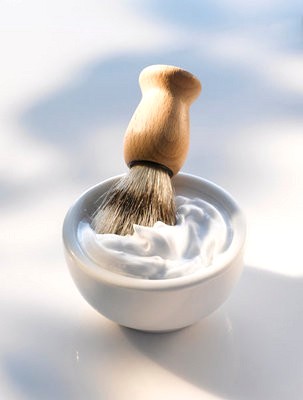 Dry lather is a common problem. The cause is that the water that used to be in the lather has evaporated, leaving you with a cake-y mess on your face. Once the water is removed from lather, all we’re left with is soap. Soap which wants to just blow off in flakes or cling stubbornly to our face.
Dry lather is a common problem. The cause is that the water that used to be in the lather has evaporated, leaving you with a cake-y mess on your face. Once the water is removed from lather, all we’re left with is soap. Soap which wants to just blow off in flakes or cling stubbornly to our face.
This is a very bad problem for straight razor shaving. Even with a well honed razor, you cannot shave with dry or drying lather. The straight razor needs a slick lather; we like tallow soap for this reason. Thankfully the solution is simple. Just dip your brush in hot water (you could use cold too if you really want) and relather the dry areas. A good practice in the beginning is to shave half your face, or one third, before relathering the next area. This way, your lather will be nice and slick; making it easier for your well honed straight razor to cut through those pesky hairs.

